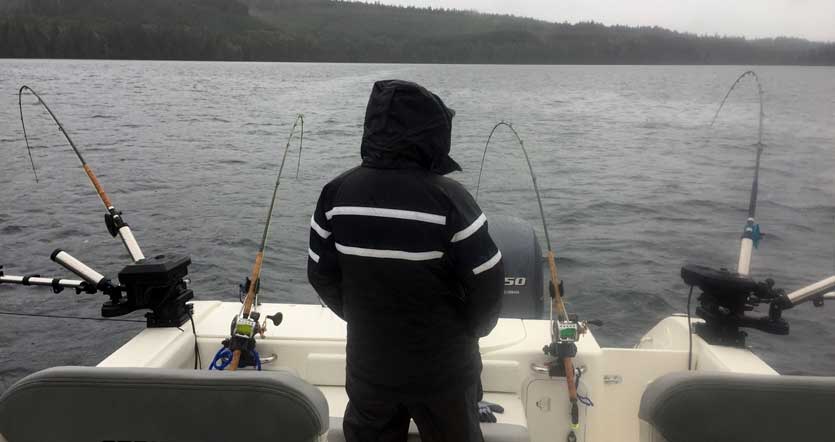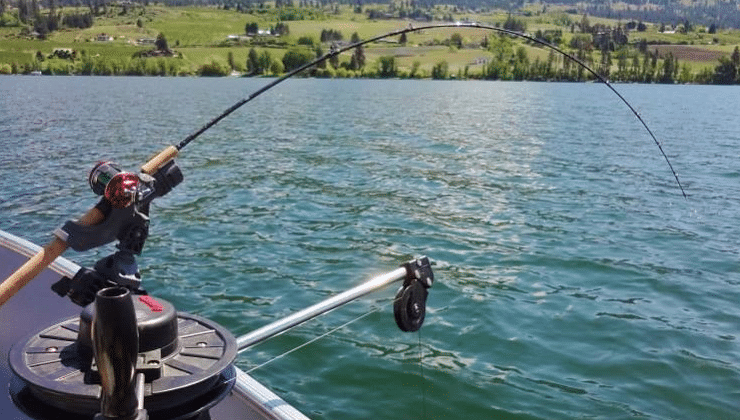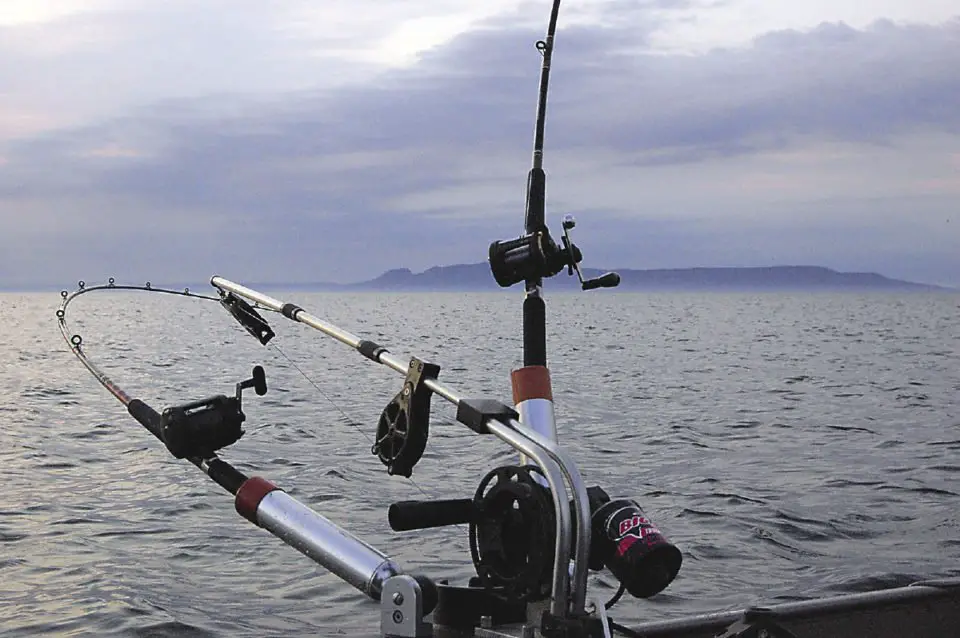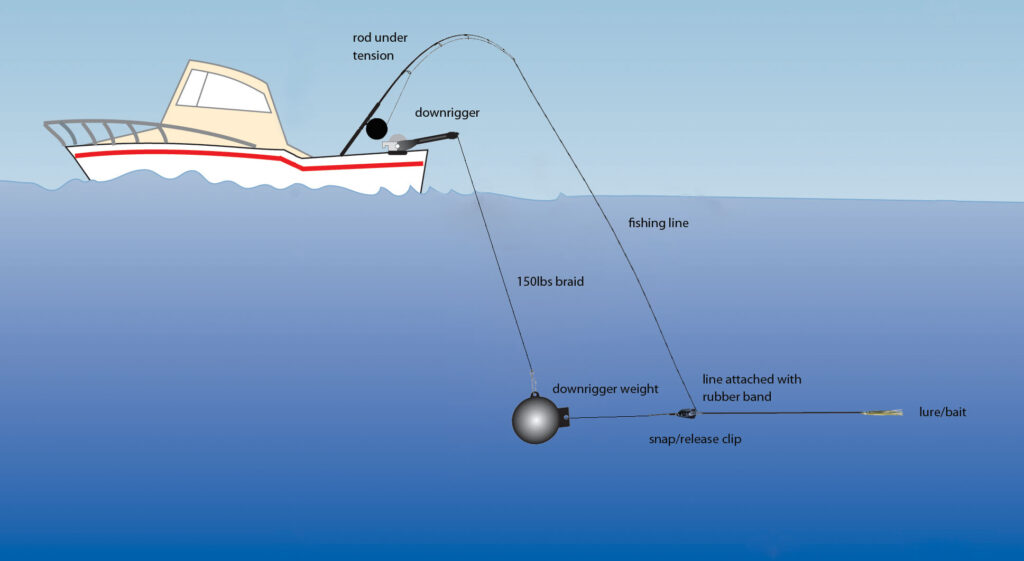Downriggers are an efficient way to place live bait and lure in precise zones of the water column, and all anglers know that being in the right depth leads to more successful fishing. Downriggers are consistently used by boats to target fresh and saltwater fish but seem intimidating until you see how they work. How Do Downriggers work?
A Downrigger either manual or electrically powered, mounted to a boat works by using a weight attached to 1 or more fishing rod lures to keep them accurate at a certain depth in the fresh or saltwater column while trolling at a level that is determined by you or a fish finder
Downriggers, both the manual and electric models both have their pros and cons, the manual being more portable and less expensive but it depends on what you are mounting it to, how big it is, and how deep you fish.
How Do Downriggers Work
A Downrigger is a fishing device that is designed for trolling from any size boat. It can be used to fish a large variety of freshwater and saltwater fish. Downriggers are used when trolling for fish below the surface, which requires lures or bait to be kept at a specific depth in the water column while the boat is moving.
Downriggers are commonly used to target many Salmon, Striper, and Lake Trout species in freshwater when they’re in shallower depths than in the summer months. Saltwater species like Tuna, Grouper, and every fish in the sea will strike a lure on the move.
Downriggers are made up of four main components:
- A cannonball weight, generally 10 to 15 pounds,
- Steel cable
- A 6 ft horizontal pole or boom
- A spool.
- Downrigger Clips adjust what depth the lure will be at-one side is attached to the downrigger and the other clip is attached to your fishing line.
 A fishing line is attached to the downrigger cable by way of a line release. The weight is typically a five-to-twenty-pound mass of lead which is connected to a steel cable. The spool is brought up either manually by way of a hand crank or by an electric motor.
A fishing line is attached to the downrigger cable by way of a line release. The weight is typically a five-to-twenty-pound mass of lead which is connected to a steel cable. The spool is brought up either manually by way of a hand crank or by an electric motor.
A fish finder will determine at what depth in the water column you want your line and the downrigger will bring your fishing line and lure down to that determined depth in the water. After you set the depth, then you can make any adjustments. With fish like salmon and trout that strike the bait from below the angler would set just above the school.
It’s important that attention be paid to the depth in the water that could change rapidly. Running your downrigger onto rocks could cause damage to the system. Some Downriggers are equipped with automatic compensation connected to your fish finder so that if the depth changes quickly the motor will kick on and pull up avoiding problems.
While trolling, the flash weight keeps your lure at your desired depth, allowing the lure to “swim” directly behind the weight. Once a fish takes the lure, the line release lets go of the line and the fish is on. When you see a fish is on, the rod will stand up the angler grabs the rod from the holder and let the fight begin.
What Does a Downrigger Do
Downriggers:
- Are spooled with several hundred feet of cable
- lower weight down through the water column taking tour lure with it
- Hold it at a set depth and then retrieves it back to the surface when needed
- A counter lets the angler know how many feet of cable is out while your fishing line is attached to a line release
- Clips attach the fishing rod’s line to the Downrigger’s line at the weight
- When a fish takes the lure from your line the Clips are released
- That line will slip free when a fish strikes so you can reel it in disconnected from the ball.
How to Use a Downrigger
- First, set up your fishing line with the lures you want to troll with. To rig attach the trolling weight to your line with a “line release.” Place the rod in the rod holder
- Attach the Clip 2-21/2 and a half feet above the water line
- Attach the other side of the Line Release Clip to your fishing line
- Set your depth in the water column with the Downrigger and lower your line accordingly
- Keep some tension on the fishing line
- Put your pole in the Downrigger holder
- Set the brakes and lock it down
- Reel up a foot or so to add tension until the rod forms an arc
With a manual system Downrigger, you will have to crank the cannonball up with one hand while you fight the fish with the other (unless you are with someone else). With a motorized system, you just flip the switch. You can fight the fish with both hands while you wait for the cannonball to reach the surface That is the beauty of the motorized system.
Downrigger Setup Diagram
1. Rod Holder Spool 2. Crank or Motor Cable 3. Boom 4. Trolling (or Flash) 5. Weight 6. Trolling Weight 7. Line Release Clip
Working Cable Slack and Release Clip on Downrigger
A downrigger is a device used while fishing deeper water using the trolling method, which places a lure at the desired depth in the water column. Essentially a manual Downrigger is a winch system equipped with a handle, a downrigger is spooled up with a chord, wire, or even braid.
It consists of a horizontal pole 2-5 ft long that supports weight like a giant sinker called a cannonball, generally, 4 to 15 pounds, that enables the rod’s lure (connected by a release Clip that looks like a cloth pin) to get to depths in the water column that you would not be able to with standard equipment. The faster you are trolling the deeper you are fishing and the heavier weight you need.

From the trailing section of the cannonball, the line from your rod attaches to the Release clip, so when a fish takes your lure it pulls off and disconnects from the weight and is free to fight.
When using a lure you want to make sure that the rod line is taught put some load on it until the rod arcs, don’t kill it but if using live bait you’ll want a little more slack in the line.
- Put the boat in gear, to create forward motion which will reduce tangles. Using whatever setup you choose on your rod let out 5- to 25 feet of line.
- Attach the line to the downrigger clip. Free spool the reel but keep your thumb on the spool and slowly lower the downrigger weight to the desired depth while making sure your reel doesn’t backlash.
- Depending on the size and style of the weight that you use, as well as the speed at which you troll, the downrigger cable extends at an angle into the water rather than straight up and down. This is called blowback.
Make sure the Release Clip is not on too tight as in many cases it is so you will need to eyeball the line just in case the rod doesn’t fly up and signal a bite. If you do get a bite and the line doesn’t release from the Downrigger then grab your pole-reel down-thumb the spool and lift the rod up releasing it from the Clip then reel it in.
In most cases, the fish will be under enough pressure to disengage the Release Clip but not always. The longer the fish bites against the Clip the better your odds of losing the fish will be. Keep the Clip on as light as possible while still holding it in place.
These manual and electrical setups along with all the accessories like the Clips, Crank, Boom, or Motors run from the very small right on up to ocean size for giant tuna and marlins. The weights can have a fin attached that controls some of the movement that trolling creates. In a situation where you have to fish deep for any length of time, a Downrigger is an important tool for catching fish in any serious angler’s arsenal.
SUPs (Stand Up Paddleboards) are H2O boards that can be outfitted for fishing, cruising, exploring, or any type of recreation that is done on a lake, river, or ocean activity SUPs come in: inflatable or solid construction 3 sizes & shapes Short-<10′ Medium-10-12′ Long-12′ 6″ 2 Hulls-Planing & Displacement ………………………………………………………………. Read more
What is a Kayak Outrigger Kit?
Kayak Outriggers Kit consists of:
Aluminum frame to minimize weight
One or more lateral support PVC inflatable/non-inflatable floats fastened to one or both sides of the main hull
Hinges for adjustment of height
Stainless steel or PVC mounting hardware
Built-in rod holders where floats are attached .……………………………………………………………………………………………………………. Read more
Downriggers come with many options and accessories, some electric downriggers are powered and built for working on bigger saltwater boats, or manual crank setups are smaller downriggers made for kyack fishing that basically work the same as the electric ones.
A heavy weight is a helpful cannon ball combined with a release clip attached to your fishing rod clip. You let the weight down to the bottom at the desired depth in the water column that’s wanted.
You control that depth (normally from information from a fish finder) while trolling lures which is the function of Downrigger fishing. It is easy to see how downriggers work.
What are some Differences Between a Stand Up Paddleboard (SUP) and Kayaks?
Kayaks:
Displacement hulls-provide better tracking
Sit close to the H2O
Better in wind
Easier on your body
Foot Pegs give paddling power
Double bladed paddles
SUPs:
Room for Fishing equipment
Added Balance
Paddles are single blade
Stand high with better views
Good stability
Variety of sizes
Easy to store & move ………………………………………………………………………………………………………… Read more
JimGalloway Author/Editor



